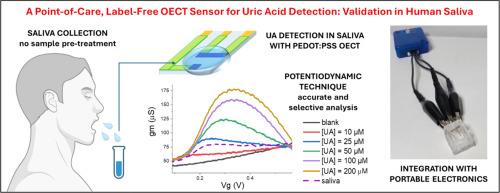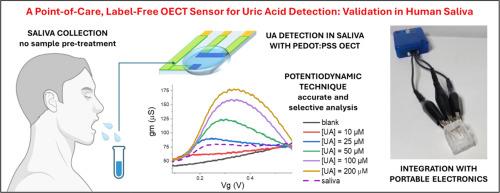点护理,无标签OECT传感器尿酸检测:在人类唾液验证
IF 5.6
3区 材料科学
Q1 ELECTROCHEMISTRY
引用次数: 0
摘要
本研究提出了一种有机电化学晶体管(OECT)传感器,用于检测人体唾液中的尿酸(UA),采用电位测量技术。与许多现有的(生物)传感器不同,该装置完全基于有机半导体聚(3,4-乙烯二氧噻吩):聚苯乙烯磺酸盐(PEDOT:PSS),简化了制造和维护,降低了生产成本。首先,系统比较了恒电位法和动电位法在缓冲溶液中的传感性能,证明了动电位法具有较高的准确度(14%)、重复性(5%)和再现性(8%)。特别是,在10 - 350 μ M UA浓度范围内,灵敏度为59 μ S dec−1,检测限为1 μ M。然后介绍了用唾液UA定量的独立方法对人类唾液中的电位动OECT传感器进行选择性研究和随后的验证,之后我们展示了我们的传感器在食物摄入过程中唾液UA监测的应用,以及对猪唾液分析的尝试。此外,由于传感器的设计支持与护理点平台集成,我们展示了其与便携式电子设备和智能手机连接的功能。这种方法可以实现快速、实时的监测,为临床环境中的无创UA检测提供了一种实用且经济高效的解决方案。本文章由计算机程序翻译,如有差异,请以英文原文为准。


A point-of-care, label-free OECT sensor for uric acid detection: Validation in human saliva
This study presents the development of an organic electrochemical transistor (OECT) sensor for the detection of uric acid (UA) in human saliva, employing a potentiodynamic measurement technique. Unlike many existing (bio)sensors, this device is entirely based on the organic semiconductor poly(3,4-ethylenedioxythiophene):polystyrene sulfonate (PEDOT:PSS), which simplifies manufacturing and maintenance and reduces production costs. First of all, a systematic comparison between the potentiostatic and potentiodynamic sensing performance in buffer solution is presented, which proves the superior accuracy (14 %), repeatability (5 %), and reproducibility (8 %) of the potentiodynamic approach. In particular, a sensitivity of 59 µS dec−1 is obtained in the concentration range 10 – 350 µM UA, with a detection limit of 1 µM. Selectivity studies and subsequent validation of the potentiodynamic OECT sensor in human saliva with an independent method specific for salivary UA quantification is then presented, after which we show the application of our sensor to salivary UA monitoring during food intake, as well as the attempt to analyze swine saliva. Furthermore, as the sensor's design supports integration with point-of-care platforms, we demonstrate its functionality with portable electronics and smartphone connectivity. This approach enables rapid, real-time monitoring, offering a practical and cost-effective solution for non-invasive UA detection in clinical settings.
求助全文
通过发布文献求助,成功后即可免费获取论文全文。
去求助
来源期刊

Electrochimica Acta
工程技术-电化学
CiteScore
11.30
自引率
6.10%
发文量
1634
审稿时长
41 days
期刊介绍:
Electrochimica Acta is an international journal. It is intended for the publication of both original work and reviews in the field of electrochemistry. Electrochemistry should be interpreted to mean any of the research fields covered by the Divisions of the International Society of Electrochemistry listed below, as well as emerging scientific domains covered by ISE New Topics Committee.
 求助内容:
求助内容: 应助结果提醒方式:
应助结果提醒方式:


